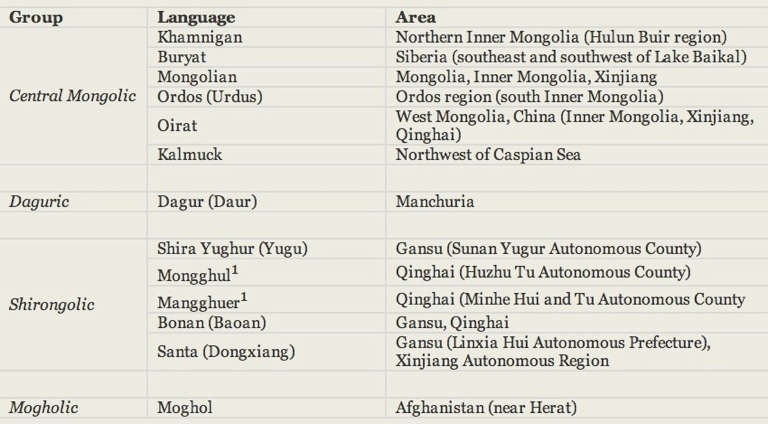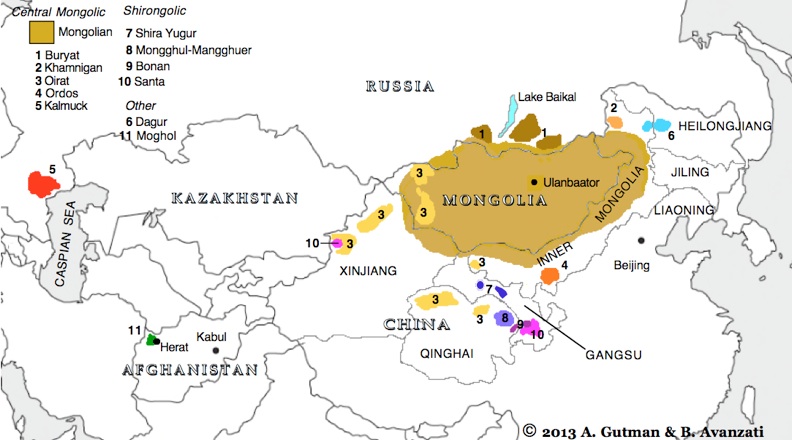An insatiable appetite for ancient and modern tongues


Alternative Name: Mongolian languages.
Overview. Mongolic is a well delimited family of a dozen fairly similar languages derived from the one spoken by the Mongols of Genghis Khan, who in the 13th century created the largest continuous empire the world has ever seen. The Mongol heartland was the Mongolian Plateau, a region of steppes and high mountains at the core of Inner Asia that supported a nomadic and pastoralist way of life. The rapid disintegration of the Mongol Empire accelerated the linguistic fragmentation that produced today's modern Mongolic languages.
Distribution. The geographical centre is Outer Mongolia (the modern Republic of Mongolia) and Inner Mongolia (an autonomous region within China). Other Mongolic-speaking populations are found in Manchuria, the Gansu-Qinghai corridor, and Xinjiang in China; around lake Baikal (Buryatia) and the Caspian Sea (Kalmykia) in the Russian Federation, as well as in a tiny area of Afghanistan.
Map of Mongolic languages distribution (click to enlarge it)
External Classification. Mongolic languages are considered one of the three subfamilies of the Altaic family by many scholars with Tungusic and Turkic. However, the parallelisms between the three are too few, according to others, to support the unity of Altaic and, therefore, they may be independent families.
Internal Classification. The core language of the family is Mongolian which is surrounded by closely related languages: Khamnigan in the northeast, Buryat in the north, Oirat in the west and south, and Ordos in the south. Further afield there are other, peripheral, languages: Dagur in the northeast, Kalmuck and Moghol in the west and the Shirongolic group in the south.

-
1.Mongghul and Mangghuer are called together Monguor by many specialists and Tu by the Chinese.
-
Mangghuer is also called Mine Mangghuer.
Status. Mongolian is the official language of the Republic of Mongolia. Many of the other Mongolic languages are declining and/or endangered. Moghol is virtually extinct.
Speakers. Mongolic speakers number around 7.5 million, of which 2.5 million live in Mongolia, more than 4 million in Inner Mongolia and other parts of China, and 600,000 in Russia. Mongol is, by far, the largest language.
Mongolian
Buryat
Santa
Oirat
Kalmuck
Ordos
Dagur
Mongghul
Mangghuer
Bonan
Shira Yughur
Khamnigan
Moghol1
5,900,000
350,000
350,000
300,000
100,000
100,000
100,000
100,000
25,000
6,000
3,000
2,000
?
1. Moghol is nearly extinct, the actual number of speakers (if any) is unknown.
Oldest Documents. The earliest documents were written in Middle Mongolian in the 13th century CE. Among them the Stele of Yisüngge, a short report on an archer's race, and the Secret History of the Mongols, a historical narrative telling the deeds of Genghis Khan.
SHARED FEATURES
Though Mongolic is a tightly knit family, there is a cleavage between the central Mongolic and peripheral languages. The latter have preserved a number of archaic features lost in the central ones, and at the same time have experienced some radical phonological and typological changes influenced by their contact with neighboring non-Mongolic languages like Chinese, Tibetan and Iranian. They also have a lesser percentage of native vocabulary having borrowed more or less extensively from them.
-
✦ Phonology
-
-Most Mongolic languages share a seven vowel system composed by i, e, a, u, ʊ, o, ɔ, and all of them, except Moghol, Mangghuer and Santa, have also long vowels. Different systems of vowel harmony, like palatal and labial, are widespread.
-
-Stop and affricate consonants are 'strong' or 'weak'. The majority of weak consonants are plain voiceless though there are also some voiced ones. Strong consonants are also voiceless but have some degree of pre- or post-aspiration. Many consonants can be palatalized and the difference between palatalized and unpalatalized varieties may be phonemic.
-
✦ Morphology
-
Nominal
-
-Mongolic languages are agglutinative and suffixing. To invariable stems inflectional and derivative suffixes are added.
-
-Nouns and pronouns are inflected for a variety of cases (up to seven or eight) to indicate functional relationships within the sentence. Proto-Mongolic is thought to have had seven cases: nominative (unmarked), accusative, genitive, dative, ablative, instrumental and comitative.
-
-Gender is not usually distinguished but number is. Many languages mark the plural but others, like Mongghul, Mangghuer and Bonan, mark the singular as well. Bonan has also a paucal number (some, a few).
-
Verbal
-
-The verbal system encompasses finite forms (indicative and imperative), participles and converbs. The indicative finite forms encode temporal-aspectual categories in which tense and aspect are intertwined. In Proto-Mongolic six existed: narrative, durative, deductive, terminative, confirmative and resultative. In Modern languages some of these categories had acquired a more temporal than aspectual connotation. Thus, the durative generally serves as the present tense, while the confirmative, resultative and terminative are used for the past tense. The imperative forms express a variety of modal shades like command, request, wish, willingness or intention; each of them can be used only with certain persons (first, second, or third).
-
-Participles, which are inflected like nouns, play a crucial role in conveying aspect as well as a temporal dimension. Proto-Mongolic had five participles, futuritive, imperfective, perfective, habitive and agentive, each marked by a specific suffix. They are all present in Modern Mongolian but only the futuritive, perfective, and agentive are attested in all Mongolic languages.
-
-Mongolic languages employ converbs to express temporal, aspectual and modal relations between two actions. Proto-Mongolic seems to have comprised at least seven: modal, imperfective, perfective, conditional, terminative, final and preparative. The number of converbs and the extent of their use varies greatly between different languages, ranging from just one converb in Moghol to more than twenty in others.
-
✦ Syntax
-
-The basic word order of all Mongolic languages is Subject-Object-Verb. The copula may be omitted in many languages. In the nominal phrase the genitive and nominal modifiers precede the head noun.
-
-Syntactic relationships are indicated by the case system supplemented by postpositions. Converbs are used to link clauses in the sentence.
Lexicon
In pre-modern times Mongolic neighbor languages included Turkic to the west, Tungusic to the northeast, Chinese to the southeast and Tibetan to the south. The greatest number of early loanwords derives from Turkic, but there are also many borrowed from Tungusic. Early Chinese and Tibetan words entered Mongolic mainly through Ancient Uighur. Direct contacts with Chinese and Tibetan seem to date mainly from a later period.
More recent word loans are evident in Buryat Russified vocabulary and in Manchu influence in Dagur. In the more peripheral languages the scale of borrowing increases dramatically. The Shirongolic languages, particularly Bonan, Santa and Mangghuer, have been influenced by Chinese and Tibetan while Moghol not only incorporated many words from Iranian languages but also altered its grammatical structure.
Scripts
From the 13th to the 15th centuries, Mongolian was written in one of four scripts: Classical or Literary Mongolian (an adaptation of the Uighur alphabet), Phagspa (derived from Tibetan), Chinese and Arabic. Nowadays, in the Republic of Mongolia it is written in the Cyrillic alphabet but in China the Classical Mongolian alphabet is still in use. Many Mongolic languages employ also Classical Mongolian in their writings, or the scripts of their countries. The Oirats developed their own script which was adapted from Classical Mongolian by the Oirat monk Zaya Pandita in 1648. This 'Clear Script' has been in use until recently but now is being replaced by Classical Mongol in China and by Cyrillic in Russia. Kalmuck also uses the Cyrillic alphabet.
-
© 2013 Alejandro Gutman and Beatriz Avanzati
Further Reading
-
-The Mongolic Languages. J. Janhunen (ed). Routledge (2003).
-
-The Perilous Frontier: Nomadic Empires and China. J. T. Barfield. Blackwell (1989).
-
-The Mongols. D. Morgan. Blackwell (1986).
-
-Die Mongolen: Beiträge zu ihrer Geschichte und Kultur. M. Weiers (ed). Wissenschaftliche Buchgesellschaft (1986).
Mongolic Languages

Address comments and questions to: gutman37@yahoo.com
MAIN LANGUAGE FAMILIES
LANGUAGE AREAS
Languages of Ethiopia & Eritrea
LANGUAGES by COUNTRY
LANGUAGE MAPS
-
• America
-
• Asia
-
Countries & Regions
-
-
Families
-
• Europe
-
• Oceania
